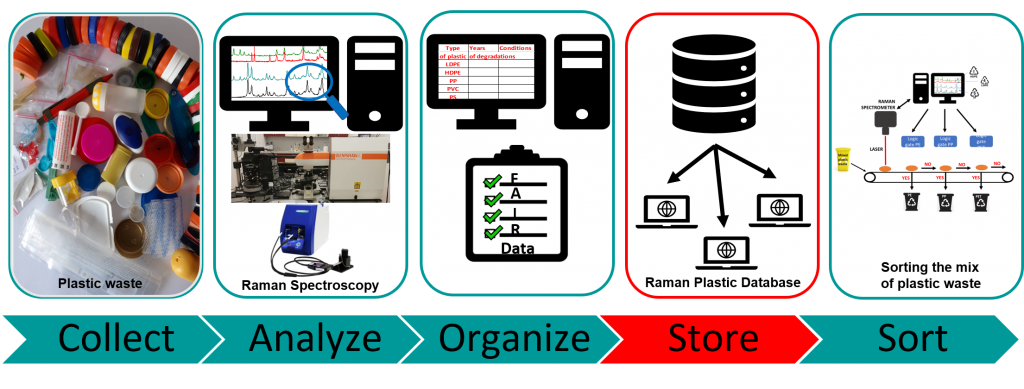Plastic Raman database comprises Raman spectra of naturally aged plastics, both macro- and microplastics, including standard plastics.
It comprises plastics aged for years both in terrestrial or aquatic conditions and characteristic spectral information, images of samples and relevant description of various plastic waste samples collected from natural environment. It covers 6 recyclable types of plastic: polyethylene terephthalate (PET), high-density polyethylene (HDPE), polyvinyl chloride (PVC), low-density polyethylene (LDPE), polypropylene (PP), and polystyrene (PS).
The database has been created to support researchers, academia, enterprises, policymakers, stakeholders dealing with global plastics waste management, and relying on knowledge-based information on waste plastics structure and properties at molecular level, particularly when it comes to years-aged plastics in natural conditions. Plastic Raman database can support the initiatives of ISO technical committees for preparing the approval criteria needed to implement the regulations regarding microplastics control using Raman spectroscopy techniques
References:
Marica, I., Pînzaru, S.C., 2023. A Raman spectral database of naturally aged plastics: A proof-of-concept study for waste plastic sorting. J. Raman Spectrosc. 54, 305–313. https://doi.org/10.1002/JRS.6484
Marica, I., Aluaș, M., Cîntă Pînzaru, S., 2022. Raman technology application for plastic waste management aligned with FAIR principle to support the forthcoming plastic and environment initiatives. Waste Manag. 144, 479–489. https://doi.org/10.1016/J.WASMAN.2022.04.021
Nesterovschi, I., Marica, I., Andrea Levei, E., Bogdan Angyus, S., Kenesz, M., Teodora Moldovan, O., Cîntă Pînzaru, S., 2023. Subterranean transport of microplastics as evidenced in karst springs and their characterization using Raman spectroscopy. Spectrochim. Acta Part A Mol. Biomol. Spectrosc. 298, 122811. https://doi.org/10.1016/J.SAA.2023.122811
Motivation
Unfortunately, plastics (both macro- and micro-) are worldwide recognized as one of the most serious threats to the planet’s environment because of the pollution they create and yet unknown impact on living organisms after uptake for years. It has become imperative to innovatively improve the plastic waste management starting with RECOVERY, IDENTIFICATION, SORTING and further recycling according to the principles of circular economy.
Among the challenges posed by the weathered macro- and microplastics in the environment, one is to collect and sort them at feasible costs for reuse purpose. Commercial plastic waste appears much more complex and the characteristic polymer Raman signal can be altered on one hand due to natural factors such as long term solar atmospheric or seawater exposure, biofilm deposition or other aggressive agents and, on other hand, due to intrinsic factors such as pigments, fillers or other blends components. To date, little is known regarding Raman spectral feature of long term (years) aged polymers.
Thus, aiming to support a sustainable plastic waste management initiative based on Raman Spectroscopy technique, we analyzed a high stock of plastic waste samples degraded for years in the natural environment comprising the 6 most common plastic types. We succesfully determined the molecular changes related to aging and pigments of the stock of plastic degraded for years in environment (see the results here: https://doi.org/10.1016/j.wasman.2022.04.021).
More than a Raman spectral characterization of plastics waste, a plastic Raman database was built up and further propose it as an effective tool for innovative Raman sorting algorithm of plastic waste, including the long-term aged plastics. More details about the Plastic Raman Database can be accesed here: https://doi.org/10.1002/jrs.6484.
